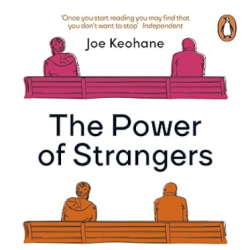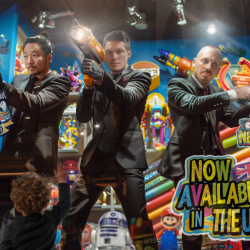In Joe Keonhane’s book, The Power of Strangers, he argues that modern life is designed to minimise encounters with strangers, (noise cancelling headphones and self-checkouts, working from home and ordering anything via an app).
The legions of strangers who serve our needs become little more than instruments of use, condemned to permanent strangerhood.
Joe Keonhane
Instead, he argues that we need to recognise the importance of talking to strangers and that there is power in conversing with strangers to combat prejudice, limit loneliness, and enable people to see the world differently — ultimately allowing us all to be a little happier.
Research commissioned in Illinois in 2013 shows that people encouraged to have conversations with strangers in places (namely transit), which didn’t usually see conversation between strangers, were happier, more positive and uplifted after their interaction. The experiment was replicated in the UK in 2019 by the BBC, and the results were the same.
In a nation plagued by loneliness, we’ve seen various grassroots organisations pop up to try and get Britons to talk in cafes and pubs. For example, the Chatty Café initiative has 900 locations across the UK. In 2019, the BBC started the series called Crossing Divides, which included a ‘Chatty Bus’ to connect over ‘social, cultural or ideological differences. Meanwhile, Trigger Conversations, an initiative to drive confidence in ‘the lost art of conversation’, has now claimed to have engineered 6,000 meaningful conversations.
We all know deep-rooted barriers prevail around interaction and conversation with strangers, but to agree with Keonhane, ‘strangers, rather than the cause of our problems, are actually the solution’.
I would argue, it’s time indeed for our industry to embrace strangers to get to better work for our brands and to be happier people as employees.
We should do so in three diverse but important ways:
1. Dwell with strangers in both finding the problem and solution
As journalists and ethnographers make strangers the core source of all truth, and street photographers document the fascinating lives of strangers, these disciplines bake interactions with strangers seamlessly into their processes, and yet often, the marketing world leaves this dialogue with strangers out of the process in deep qual or observation through ethnography, and interaction becomes more a nice to have.
William Buckingham in Hello Stranger quotes the sociologist Georg Simmel, who found in his research that strangers trade ‘the most surprising revelations and confidences, at times reminiscent of a confessional.‘ It’s in spending time with strangers that we unlock deep human truths, that we learn about how our brands are received and rejected. And how people live, as well as live to not just consume us. By spending time with strangers, we get to understand hesitancy to make behaviour change, or drivers to purchase. Catherine Carr, journalist, hits the nail on the head: ‘I potter around a location talking to strangers and asking them that one simple question. The answers are always interesting. Sometimes they’re funny, sometimes surprising, tragic or shocking. Occasionally they take your breath away.’
Dwelling with strangers has given us anything from improved product to improved campaign — from hike-alongs with The North Face and explorers getting to better placement of pockets on clothing to the beautiful insight from Persil in Dirt is Good.
2. Find strangers in growth audiences
It’s never been harder to grow, in heavily commoditised marketplaces and shrinking audience pools, brands must seek not only to convert their familiar players, consider strangers previously unconsidered — opposites in gender, adjacent spaces in segment, diversity in all its wonderful forms as hygiene, not a nice to have or tick box. Take baby milk, in a category used to just talking to mum, a birth rate declining by 3% YOY and an increasingly competitive marketplace, NOT talking to dads, adjacent audiences (e.g. grandparents and carers) is just a missed opportunity.
3. Embrace strangers in other brands
The best brand-to-brand collaborations out there today, mash strangers together. These stranger interactions take the form of various collab archetypes. Take the Old and New collab archetype — 171-year-old sewing machine brand collaborating with the 1994 Supreme label, or the David and Golliath collab archteype of Channel Four and Vinted or the Accessible Lux collab archetype of Liberty and Uniqlo.

Mashing strangers in brand collabs gives brands new growth audiences they’d not even thought of, surprises audiences by writing the next chapter in a brand’s long narrative and makes the brands desirable (again).
We need to set ourselves up to formally make stranger interaction part of the process, from fabulous office spaces like Sea Containers, which allow for serendipitous collisions akin to the coffee houses of the enlightenment, to crafting simple guidelines for how to speak to and observe in agenda-less exercises to uncover deep hidden truths about the human psyche. Identifying practices akin to street photography’s shoot from the hip technique. We need to formally bring strangers into our lives and our work.
Featured image: Jessica Yap / Unsplash


























